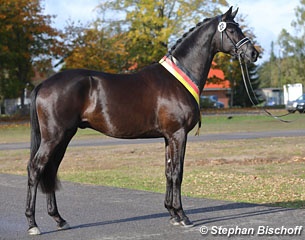
(by Dr. Maren Engelhardt) Before we begin – yes, in 2017 we again have a Champion by Millennium. But hold your horses. First of all, every horse has a mother too; second, a good horse is a good horse and third, trust me, I am one of the biggest sceptics out there when it comes to that particular stallion in Sprehe’s barn and yet there really was no doubt this was a deserving Champion.
Millennium as a sire doesn’t mean we can dis the pedigree before we even look at the animal behind it. And that is where I stand right now, as objective as I can be, getting ready to pin down another “opinion piece” for Eurodressage. Because that is what this is – my personal observations and opinion, based on 2.5 days of close contact to these magnificent animals in and around the Holstenhallen in Neumünster this October of 2017.
Like all other breed registries in Germany, the Trakehner Verband is producing fewer foals per year than it used to. And with that, fewer aspiring stallion candidates show up to choose from when it is time for pre-selections. I happened to attend some of those this year and have to say that generally, I think we see already a more select group of colts presented at these sites in August than we used to 15 or even 10 years ago. Fewer foals, by logic, also means less mass to select quality from, because you narrow your options. It’s tempting to just think that because of the economic realities, only the best mares get bred …. However that is not how genetics work. As we all know, even the “best mares” with the “best stallions” hardly guarantee “best foals”. Rather, I have the feeling that breeders have become more critical of what really should be a stallion candidate and what should head for a sport horse career right away (as a gelding). One doesn’t exclude the other of course. I don’t have the feeling we see mediocre horses just because we have fewer foals. I do think that the genetic variety is in serious trouble though. The Trakehner breed produces around 1100 foals annually in all of Europe, of which less than 100 show up for the pre-selections in Germany. In 2017, 32% were from the same direct stallion line (Kostolany, 24% via Gribaldi alone). That cannot be good, ever. More on that later.
In 2017, 34 colts out of roughly 100 had been selected on the tour that brings the breed director, Lars Gehrmann, and his team literally all over the country. The Trakehner has no home state, or even home “hall” to be attached to like you know from Verden, Vechta, Handorf or Elmshorn. Breeding Trakehners means that if your colt is selected and you live e.g. on the Austrian border, you and your horse are in for a 1,800 km round trip just to show up. That takes passion and dedication.
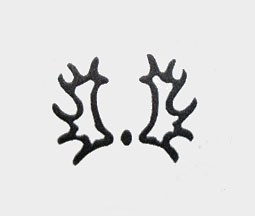 The breed is also one with a closed studbook, which sets it apart from all other warmblood breeds. This means that the only outside blood source available to Trakehner breeders are Thoroughbreds (xx, ox, x, ShA, AA). Consequently, any kind of “improvement” or change in type, movement or athletic abilities has to come from within this pool. True outcross is difficult to find, but became a bit more realistic after the wall came down and all of a sudden, breeders could tap into the vast expanse of Eastern European lines. For decades, these had been selected much more for riding horse traits than beauty contests. It was a big chance and one that breeders only slowly embraced. Nevertheless, I would think that overall the verdict can only be positive – this brought a number of top jumpers into the program and with that, stallions and mares that had more strength in their hind end and more power over their toplines for the dressage horses to profit from as well.
The breed is also one with a closed studbook, which sets it apart from all other warmblood breeds. This means that the only outside blood source available to Trakehner breeders are Thoroughbreds (xx, ox, x, ShA, AA). Consequently, any kind of “improvement” or change in type, movement or athletic abilities has to come from within this pool. True outcross is difficult to find, but became a bit more realistic after the wall came down and all of a sudden, breeders could tap into the vast expanse of Eastern European lines. For decades, these had been selected much more for riding horse traits than beauty contests. It was a big chance and one that breeders only slowly embraced. Nevertheless, I would think that overall the verdict can only be positive – this brought a number of top jumpers into the program and with that, stallions and mares that had more strength in their hind end and more power over their toplines for the dressage horses to profit from as well.
The Trakehner generally is confronted with two wide-spread prejudices: The notion that they just cannot perform at the highest levels and the issue of being “crazy” as in unrideable, not cooperative, and more pretty than useful. This has been repeated so often that it has become fact over fiction. In fact when you find yourself in a discussion, carefully arguing a point that sees this a bit more critical, you will automatically experience that you’re seen as naïve and just not “getting it”. Of course, there is truth in this assessment – the breed did go through seriously dark ages, but as pointed out above, the task of creating something better out of a very limited genetic resource takes serious breeding skills. Trakehner dressage breeders can’t just go and use De Niro or Jazz and “improve” what is missing. Also, both historically and presently, the breed regularly competes at the very top levels in international competition, just in a discipline that many riders still don’t seem to count as real (eventing). So bear with me while I take you through some of the pedigree background of the top three placed stallions and decide for yourself if maybe there is a bit more to some of these horses that your initial instinct might dictate.
The Leading Actors at the 2017 Licensing
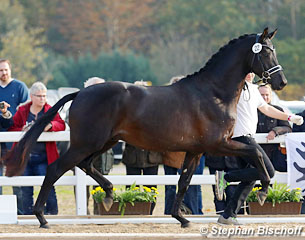 The new Champion Kaiser Milton (by Millennium – Van Deyk – Gajus) was bred by A.J.M. aan de Stegge, Enter, The Netherlands and owned Jan Pieter Dalsem, Hoorn, The Netherlands. Originally not up for sale, the owner changed his mind the day before the auction and the stallion became the top seller at 320,000 euro. He will now stand at Klosterhof Medingen. This is the 3rd Millennium son that became Champion in NMS just in the past few years and instinctively my gut reaction was “not again”. And true, my personal Champion stallion was not this one. But I’m not the approval committee and I understand why Kaiser Milton ended up in front – he was breathtakingly beautiful, with expressive gaits, especially in the trot, marked by shoulder freedom, ground cover and an engaged hind end, with nice self-carriage and good balance. His walk was ok, his canter was good, his trot quite phenomenal. Black, refined, lots of pizzazz = Millennium. This horse embodies everything that makes breeders (and not only Trakehners) return to that sire over and over again. Kaiser Milton also had that questionable walk, and the foundation and front leg conformation that makes me wonder if he will last. Yet if you can forget about the sire for a second and look at the dam, then really, this Champion stallion comes from a sport background like few others. His dam Kaiser’s Els is a full sister to Dorothee Schneider’s longtime international Grand Prix partner Kaiserkult TSF and his full brother, the Grand Prix stallion Kaiserdom TSF (Kathrin Meyer zu Strohen). And the list goes on - all in all the full siblings of this dam have won close to 110,000 euro in competition in Germany alone. And as far as the ability to reproduce sport success goes – Kaiserkult TSF has produced S level dressage horses, Kaiserdom TSF as well and both also have offspring in eventing, including the CCI2* winner Regenmann in the US. So sure, there is the questionable Millennium again – but there is also a direct mare family that has truly produced its share of highly rideable horses. So before we all dismiss this new Champion, why don’t we give him a few years?
The new Champion Kaiser Milton (by Millennium – Van Deyk – Gajus) was bred by A.J.M. aan de Stegge, Enter, The Netherlands and owned Jan Pieter Dalsem, Hoorn, The Netherlands. Originally not up for sale, the owner changed his mind the day before the auction and the stallion became the top seller at 320,000 euro. He will now stand at Klosterhof Medingen. This is the 3rd Millennium son that became Champion in NMS just in the past few years and instinctively my gut reaction was “not again”. And true, my personal Champion stallion was not this one. But I’m not the approval committee and I understand why Kaiser Milton ended up in front – he was breathtakingly beautiful, with expressive gaits, especially in the trot, marked by shoulder freedom, ground cover and an engaged hind end, with nice self-carriage and good balance. His walk was ok, his canter was good, his trot quite phenomenal. Black, refined, lots of pizzazz = Millennium. This horse embodies everything that makes breeders (and not only Trakehners) return to that sire over and over again. Kaiser Milton also had that questionable walk, and the foundation and front leg conformation that makes me wonder if he will last. Yet if you can forget about the sire for a second and look at the dam, then really, this Champion stallion comes from a sport background like few others. His dam Kaiser’s Els is a full sister to Dorothee Schneider’s longtime international Grand Prix partner Kaiserkult TSF and his full brother, the Grand Prix stallion Kaiserdom TSF (Kathrin Meyer zu Strohen). And the list goes on - all in all the full siblings of this dam have won close to 110,000 euro in competition in Germany alone. And as far as the ability to reproduce sport success goes – Kaiserkult TSF has produced S level dressage horses, Kaiserdom TSF as well and both also have offspring in eventing, including the CCI2* winner Regenmann in the US. So sure, there is the questionable Millennium again – but there is also a direct mare family that has truly produced its share of highly rideable horses. So before we all dismiss this new Champion, why don’t we give him a few years?
The Reserve Champion of the lot, the very impressive Sir Picasso (by Distelzar – Pretty Dancer – Kostolany) was bred by Charlotte Vogel from Switzerland and owned by her and Bernhard Langels, who operates the Schäplitz Stud in East Germany. The stallion was one of the most “un-Trakehnerish” stallions of that year; he wasn’t refined and most certainly didn’t win points with his typical Trakehner type. But who cares? This was one heck of an athletic horse, with outstanding power through his haunches, with a decent jump, oozing scope and talent for a serious sport horse career. He was also correct and stood on large feet. He is a great example that the breed, despite its consolidated genetics of over 270 years of selective breeding, can still produce an interesting variance in type (and I mean more than the face here). Sir Picasso is a strong stallion, one that would suit refined mares that need more drive. His sire Distelzar is Gribalid’s most successful son in the Trakehner breed, competed at international level Grand Prix and sired a number of FEI dressage horses (that surprisingly always jumped very well). Sir Picasso’s dam Sirikit was a very successful driving horse at S-level and comes from a family that produced numerous S-level dressage horses, including Peter Koch’s longtime World Cup dressage partner Shannon TSF. Bottom line was that we all felt this was a very deserving Reserve Champion and he did stand in a clear contrast to the Champion, which is interesting and encouraging. Sir Picasso was not for sale.
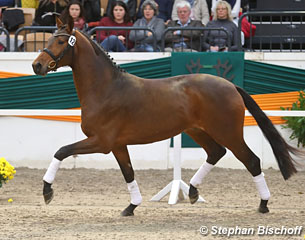 The second Reserve Champion was the noble bay United Affair (by the late Herbstkönig – Sixtus – Mahagoni), bred by ZG Thönsen and owned by a consortium of 5 friends (the Cava Konsortium), who set out 2 years ago to buy a colt and see how far they would get … for some of them, this was their very first Trakehner ever! And what a stallion ! There were a good number of people that saw him all the way at the top, mostly because he was the one horse to truly embody what the Trakehner used to be all about: the most versatile sport horse of them all, with an excellent jump as well as outstanding movement in all three gaits (yes I know … how quaint). United Affair fulfilled these criteria for sure. On top of that, he was so positively stamped by his TB ancestors, and moved with such an ease and effortlessness that he was just a joy to watch. If I had to fault him, it would be his extreme elevation through his shoulder and neck that made his topline appear almost soft at times. Then you see him jump and you know all is well there, but still, a bit more relaxation over his back would have made him look even better. His sire Herbstkönig recently passed away at a rather young age after he qualified for the Bundeschampionate (dressage) several times. The dam of United Affair already produced the approved Bundeschampionate eventer Undercover. Among others, the extended dam line also produced the Grand Prix stallion Unkenruf (Herbert Rehbein), who appears in the dam lines of such dressage heroes as Don Primero and Don Schufro. United Affair was sold at auction to Hamburg-based dressage rider Renate Weber for 100,000 euro. Hopefully he’ll get a chance in the breeding shed - he is a really good horse, sadly his sire is gone, and he is free of Gribaldi blood.
The second Reserve Champion was the noble bay United Affair (by the late Herbstkönig – Sixtus – Mahagoni), bred by ZG Thönsen and owned by a consortium of 5 friends (the Cava Konsortium), who set out 2 years ago to buy a colt and see how far they would get … for some of them, this was their very first Trakehner ever! And what a stallion ! There were a good number of people that saw him all the way at the top, mostly because he was the one horse to truly embody what the Trakehner used to be all about: the most versatile sport horse of them all, with an excellent jump as well as outstanding movement in all three gaits (yes I know … how quaint). United Affair fulfilled these criteria for sure. On top of that, he was so positively stamped by his TB ancestors, and moved with such an ease and effortlessness that he was just a joy to watch. If I had to fault him, it would be his extreme elevation through his shoulder and neck that made his topline appear almost soft at times. Then you see him jump and you know all is well there, but still, a bit more relaxation over his back would have made him look even better. His sire Herbstkönig recently passed away at a rather young age after he qualified for the Bundeschampionate (dressage) several times. The dam of United Affair already produced the approved Bundeschampionate eventer Undercover. Among others, the extended dam line also produced the Grand Prix stallion Unkenruf (Herbert Rehbein), who appears in the dam lines of such dressage heroes as Don Primero and Don Schufro. United Affair was sold at auction to Hamburg-based dressage rider Renate Weber for 100,000 euro. Hopefully he’ll get a chance in the breeding shed - he is a really good horse, sadly his sire is gone, and he is free of Gribaldi blood.
A horse that I would like to mention because it surprised me and reminded me to not make up my mind before looking at the animal was the dark grey premium Dezember (by Herakles – Imperio – Induc), bred by Dr. Eckard Lehmann and owned by Hubertus Poll of Gestüt Hörem. The stallion had no photo or video posted before the event and was only up for approval, not for sale. If Mr. Poll decides to do that, it is usually a sign to pay attention – and indeed this stallion was sort of my personal secret surprise. Elegant and noble, a true Trakehner, Dezember moved with outstanding range of motion, knew how to jump and not look like a fool, and was one of the few horses that you couldn’t really hear hit the ground in the indoor. The parallel to a feather popped up in my mind; we’ll have to see if he will develop the strength to carry this under saddle, but I am hopeful. I would have liked to see more carrying power in the canter, but overall, this was a lovely horse and well-deserved premium. Sire Herakles is a S-level dressage stallion (and also by Gribaldi), the dam Donauweise a daughter of the German Dressage Team horse Imperio (Hubertus Schmidt), who really seems to outperform himself as a sire of good young dressage horses. This mare family also boasts sport horses galore, including Christoph von Daehne’s great Donnerberg TSF, a horse with over 136 S-level wins (!) on his FN performance record.
So in the end, of 7 premium stallions, 6 were from the Gribaldi line. Really! And in the field of 13 approved stallions, another 2 carried Gribaldi blood, plus one more with Kostolany in the mix. That my friends is simply too much of a good thing.
Trakehner Breed on a Slippery Slope
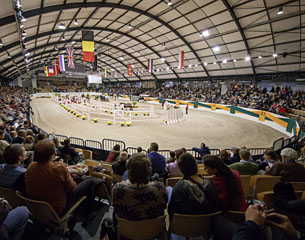 So in summary, a few general observations …. The Trakehner used to be the German breed with the best walks during approval high time every year. Note the past tense. Not anymore. The trot has been adapted to the sought-after “championship” style” with high knee action and shoulder freedom, and hocks that move like pistons (not always under the center of gravity). We have accepted all that drama to come with a loss in the department of walking over a relaxed back. That can only be trouble down the road. Similarly, with all the leg action, the canters have clearly become more expressive, but not necessarily better in terms of balance and strength. Again it kind of looks awesome, but really only if you don’t need to sit on it and consider work for the upper levels one day. Also, not just a few stallions stepped exceedingly wide with their haunches. We don’t need more of that either. Overall, especially with the Millennium colts, one could not fail to see the strange proportions concerning upper body vs. foundation. The horses are very refined now, but the bodies are still big, lots of neck, volume in the chest, big hips. The legs don’t keep up with this anymore and I’ve noticed the same with his offspring in other breeds. The tendency to develop a tied-in carpal joint is obvious; these horses also often rest on hooves that are too small for the body that sits on top. I have no problem with small feet but they have to match the horse.
So in summary, a few general observations …. The Trakehner used to be the German breed with the best walks during approval high time every year. Note the past tense. Not anymore. The trot has been adapted to the sought-after “championship” style” with high knee action and shoulder freedom, and hocks that move like pistons (not always under the center of gravity). We have accepted all that drama to come with a loss in the department of walking over a relaxed back. That can only be trouble down the road. Similarly, with all the leg action, the canters have clearly become more expressive, but not necessarily better in terms of balance and strength. Again it kind of looks awesome, but really only if you don’t need to sit on it and consider work for the upper levels one day. Also, not just a few stallions stepped exceedingly wide with their haunches. We don’t need more of that either. Overall, especially with the Millennium colts, one could not fail to see the strange proportions concerning upper body vs. foundation. The horses are very refined now, but the bodies are still big, lots of neck, volume in the chest, big hips. The legs don’t keep up with this anymore and I’ve noticed the same with his offspring in other breeds. The tendency to develop a tied-in carpal joint is obvious; these horses also often rest on hooves that are too small for the body that sits on top. I have no problem with small feet but they have to match the horse.
Without a question, the breed has come a very long way from the days of the flat front arm, efficient forward canter stride with almost no lift and the overall trend to somewhat move forward first, then up (consider the very different historical basis of this breed compared to all others and this makes sense and was actually bred for). What served this breed so well for centuries (actually also kept it pretty sound), is gone at least at the Holstenhallen during the 2-year old event of the year. Looking at the same approvals in Verden and Vechta shows generally the same thing (trot, trot, trot), and especially the Oldenburg breed has struggled to maintain a solid walk with the infusion of certain bloodlines. But now, the Trakehner is sort of following down that road; understandable if you want to produce flashy horses for the riding horse tests at the Bundeschampionate. Yet – the breed just isn’t that type of horse, no matter how much you might wish it was. So now we press it into a form that will supposedly sell well and bring a quick buck, but most likely with consequences that for this closed stud book could be devastating. We can’t easily fix what we got rid of so shortsightedly. I know I’m not the only one who thinks we’re on a very slippery slope here.
DNA Anemia
Add to that the absolutely mind-boggling dominance of the Kostolany line (not only via Gribaldi) with a few exposed stallions at the forefront (Millennium and now his sons Helium and Freiherr von Stein) and one can only conclude that this cannot possibly be healthy. Speaking of Millennium ….. clearly a horse that has a fan club and a large base of breeders using him every year. Over 30 approved sons across all registries and the stallion is just 9 years old. There’s always talk of his own fragile nerves and his non-compliance when it comes to being a riding horse. A more than meager performance record is usually brought up immediately by his biggest critics, but to be fair, a stallion with that kind of “business” from January through August really cannot do very well in competition, if he wants to or not.
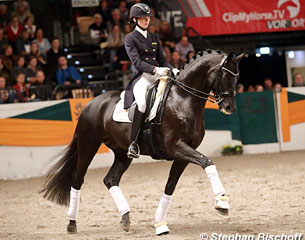 I saw Millennium privately Friday evening when he was in the big indoor with several sons and the horses had a chance to see the hall before the frantic Gala Saturday night. He was well-behaved, focused on his rider, and did what any other horse in there did that night – a good job. And I really am not a fan of this particular stallion. But just as much as it is wrong to think he’s the best thing on 4 legs that ever walked the earth (not only in the Trakehner breed!), it is just as wrong to so quickly dismiss him completely. As with any other stallion, he is certainly a good match for certain mares and breeding goals. It becomes problematic when there is almost no other choice anymore. In a way, he has become the Sandro Hit of Trakehnerdom, all the way down to the issues in walk, the somewhat electric personality and all the critique that came with it. Other than Sandro Hit though, he is infused into an already very narrow breed by the truck load.
I saw Millennium privately Friday evening when he was in the big indoor with several sons and the horses had a chance to see the hall before the frantic Gala Saturday night. He was well-behaved, focused on his rider, and did what any other horse in there did that night – a good job. And I really am not a fan of this particular stallion. But just as much as it is wrong to think he’s the best thing on 4 legs that ever walked the earth (not only in the Trakehner breed!), it is just as wrong to so quickly dismiss him completely. As with any other stallion, he is certainly a good match for certain mares and breeding goals. It becomes problematic when there is almost no other choice anymore. In a way, he has become the Sandro Hit of Trakehnerdom, all the way down to the issues in walk, the somewhat electric personality and all the critique that came with it. Other than Sandro Hit though, he is infused into an already very narrow breed by the truck load.
And he is not the only one with staggering dominance – with the rise of Millennium came the rise of another black stallion, Hörem’s Schwarzgold (8-year old). Coming up a bit more successful in the performance ring (success at M level in 2015), he is a busy boy and stamps the breed considerably. His family is one of unquestioned value in sport (his full sister Standing O’Vation TSF won the small finals the FEI World Championships for 7yr old dressage horses this year and has won several regular S-level tests this season). The extended female family is one with numerous sport horses at the upper levels in dressage and eventing (family of the English TB Cresta Star xx). And yet – Schwarzgold’s offspring often impress on first sight with exuberant movement in the front arm, but fail to connect the back end. We saw more of that this year in NMS and as with Millennium, the proof will be under saddle and so far, the big sport horse hit is missing. Granted, these stallions are 8 and 9 years old, respectively, so the offspring cannot win Grand Prixs yet. I guess time will tell, but until then, do we really want 30% of the breed from these lines?
Do Breeders Think in Generations?
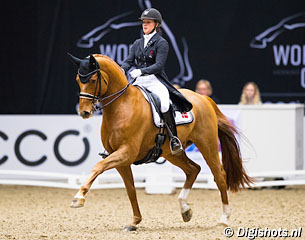 The approval commission is hardly at fault – they can only judge what they get to see. However, the Verband is very busy pushing a lot of breeders to use these supposedly modern horses and with that, is doing a lot of damage. This breed can only survive when genetic and phenotypic alternatives are available. These become increasingly slim and not with the best phenotype attached to them. I for my part thought it was almost ironic that the weekend the Trakehner breed celebrated yet another long-legged, tall, noble, black trotting machine, Cathrine Dufour rode the old fashioned, sturdy, short-legged, powerful and rather unspectacular Atterupgaards Cassidy to a World Cup win at Herning – a son of the great Trakehner Caprimond. Go watch his video, and then watch Kaiser Milton. You’ll feel you’re looking at two different animal species.
The approval commission is hardly at fault – they can only judge what they get to see. However, the Verband is very busy pushing a lot of breeders to use these supposedly modern horses and with that, is doing a lot of damage. This breed can only survive when genetic and phenotypic alternatives are available. These become increasingly slim and not with the best phenotype attached to them. I for my part thought it was almost ironic that the weekend the Trakehner breed celebrated yet another long-legged, tall, noble, black trotting machine, Cathrine Dufour rode the old fashioned, sturdy, short-legged, powerful and rather unspectacular Atterupgaards Cassidy to a World Cup win at Herning – a son of the great Trakehner Caprimond. Go watch his video, and then watch Kaiser Milton. You’ll feel you’re looking at two different animal species.
So the question for the Trakehner breed is really – where do you want to be in 10, 20 years down the road? Is the supposedly modern gang of horses that is sold to us as “breed improvement” going to be up there with horses like Weihegold or Cassidy? These are questions that all of you warmblood breeders need to ask yourself, but most of you have options off the beaten path. The Trakehners are running out of those options. That old saying of “breeders think in generations” is really worn out, but was never truer than today. Time to reconsider the consequences!
Text by Dr. Maren Engelhardt for Eurodressage
Photos © Stephan Bischoff - Leanjo de Koster
Related Links
Kaiser Milton, Champion of the 2017 Trakehner Stallion Licensing
Maren Engelhardt: Numbers Don't Lie, or Do They?
His Moment Proclaimed Champion of the 2016 Trakehner Stallion Licensing
Generous Approval at Reformatted 2014 Trakehner Stallion Licensing